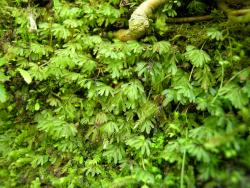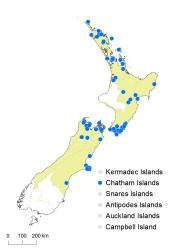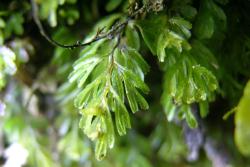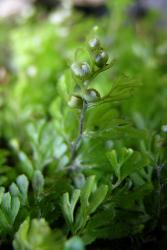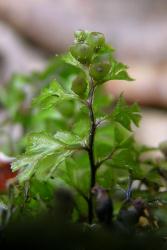- ≡ Hymenophyllum tunbridgense var. cupressiforme (Labill.) Hook.f., Bot. Antarct. Voy. II (Fl. Nov.-Zel.) Part II, 11 (1854)
- = Hymenophyllum antarcticum C.Presl, Hymenophyllaceae 50, t. 12a (1843)
Terrestrial or rupestral ferns. Rhizomes long-creeping, 0.2–0.25 mm diameter, bearing very scattered red-brown hairs up to 0.5 mm long. Fronds 15–75 mm long. Stipes 3–25 mm long, dark brown throughout, often narrowly winged in distal half, bearing very scattered hairs; stipe wings planate. Laminae 2–3-pinnatifid, ovate or elliptic or narrowly elliptic or narrowly obovate, 10–60 mm long, 5–25 mm wide, green, membranous, virtually glabrous. Rachises narrowly winged throughout, brown, glabrous or with a few very scattered hairs; rachis wings planate. Primary pinnae in 4–12 pairs, scarcely overlapping, winged throughout, ovate or elliptic, adnate; distal portion of primary pinnae straight; the longest primary pinnae above or at or below middle, 4–15 mm long, 2–8 mm wide. Secondary pinnae arising both acroscopically and basiscopically. Ultimate lamina segments oblong or linear, up to 4 mm long, 0.5–1.4 mm wide; apices acute or obtuse; margins toothed, lacking a distinct border; distal segments on primary pinnae divergent, not or scarcely curved towards frond apex. Sori borne on short acroscopic segments at the base of primary pinnae, solitary on each segment, one on each primary pinna, adnate; indusia bivalvate, usually in plane of frond or rarely bent upwards; indusial flaps usually elliptic or occasionally obovate, 1–2.5 mm long, apices obtuse or truncate, margins entire or shallowly toothed; receptacles included within indusial flaps or occasionally slightly exserted.
Hymenophyllum cupressiforme is one of several small filmy ferns in New Zealand with toothed margins. It is smaller than either H. bivalve or H. multifidum, and lacks the spines on the lamina margins of H. armstrongii, or the spines on the outer surfaces of the indusial flaps of H. minimum. It is very similar to H. revolutum and H. peltatum, but distinguished from the former by its rachises which are winged throughout, and its indusial flaps which are less prominently toothed, and from the latter by its solitary sori on each primary pinna, and by its secondary pinnae which arise both acroscopically and basiscopically. Occasionally the receptacles are slightly exserted, and the indusia bent upwards at an angle to the plane of the frond.
North Island: Northland, Auckland, Volcanic Plateau, Gisborne, Southern North Island.
South Island: Western Nelson, Sounds-Nelson, Marlborough, Westland, Canterbury.
Chatham Islands.
Altitudinal range: 0–760 m.
Hymenophyllum cupressiforme occurs in lowland to montane areas of the North Island from Te Paki to Mt Pirongia, but further south it is largely confined to the eastern side of the island. It is apparently absent from Taranaki, the Bay of Plenty and inland Gisborne. It occurs from sea level to 670 m in the Kaweka Ranges and 700 m on Mt Pirongia. In the South Island it is confined to lowland and montane areas of north-west Nelson, Lake Rotoiti, Marlborough and eastern Canterbury, extending from near sea level to 760 m on Banks Peninsula. It is known from a single collection on the Chatham Islands (AK 300747). Its overall distribution is unusual in being most abundant in central New Zealand either side of Cook Strait.
Also in Australia (Queensland, New South Wales, Victoria, Tasmania).
Occurs under light shade in kānuka and mānuka scrub, and in beech forest, less commonly in podocarp or broadleaved forest, usually growing on the ground, on rocks, scoria, or banks in damp areas.
Tindale (1963) stated that the holotype of H. cupressiforme was in FI, noting that Labillardière’s original description in his hand-writing was affixed to the specimen (FI 004205). However, there are also two other Labillardière collections in P which Tindale did not mention: Van Diemen [Tasmania], Labillardière, P 00623471! (photo WELT E476/9); Nov. Holland. [Australia], Labillardière, P – herb. Jussieu No. 1507! (photo WELT E478/7). We interpret these as separate syntypes. Nevertheless, Tindale’s original statement constitutes effective lectotypification.
Hymenophyllum antarcticum was described as a new species by Presl (1843) citing "H. tunbridgense, Sieb. syn. fil. n. 134, flora mixta n. 254. Habitat in Nova Hollandia ad Port Jackson, ubi legit Sieber". There are collections labelled "Nova Hollandia, Sieber 134" or "Synops. Filicum No. 134" in many European herbaria including B, BR, E, L, LE, P, PRC, S and W. Presl’s own herbarium is held at PRC (Stafleu & Cowan 1983). A specimen of H. antarcticum, labelled "Neu Hollandia, Siber" in Presl’s handwriting, was seen at "PR" by Croxall (1975) but identified by him only as a "probable isotype". Hymenophyllum antarcticum was accepted as a distinct species by Copeland (1938, p. 93), but reduced to synonymy under H. cupressiforme by Tindale (1963), Croxall (1975) and Bostock & Spokes (1998), but none of these authors identified the holotype or selected a lectotype. PRC 452914, excluding the frond at bottom left, was selected as lectotype by Brownsey & Perrie (2016).
The occurrence of Hymenophyllum cupressiforme in New Zealand was first recorded by Parris & Croxall (1972); before then it had been confused with H. peltatum and H. revolutum.



